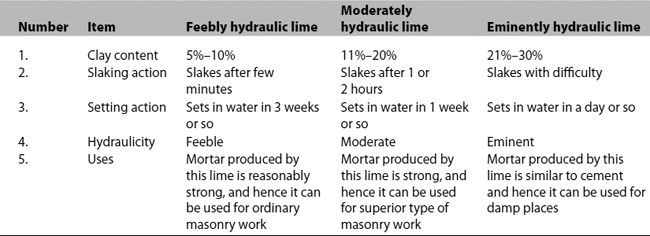Lime has been conventionally classified into the following three types, namely
- Fat lime
- Hydraulic lime
- Poor lime
Fat lime
This lime is also known as high calcium lime, pure lime, rich lime or white lime. Fat lime is obtained from pure limestone, shell and coral. When it is left in air, it absorbs carbon dioxide (CO2) from air and gets transformed into calcium carbonate (CaCO3). It is popularly known as fat lime as it slakes vigorously and its volume gets increased to about 2-2½ times the volume of that of quick lime.
The following are the properties of fat lime:
- It hardens very slowly.
- It has a high degree of plasticity.
- Its colour is perfect white.
- It sets slowly in the presence of air.
- It slakes vigorously.
The following are the uses of fat lime:
- It is used in white washing and plastering of walls.
- With sand, it forms lime mortar, which sets in thin joints. Such mortar can be used for thin joints of brickwork and stonework.
Hydraulic lime
Hydraulic lime is different in composition from quick lime in that it contains a definite amount of clay, which gives it the hydraulic property, i.e., the capacity to set and harden even under water. Quick lime does not set under water. Hydraulic lime contains CaO between 70 and 80 per cent and clay about 15–30 per cent.
Hydraulic lime is generally manufactured from a limestone that is rich in clay, or by adding clay materials to the limestone during burning of limestone. This lime is further divided into feebly hydraulic, moderately hydraulic and eminently hydraulic lime, depending upon its hydraulicity. The comparison between these types of hydraulic limes is shown in Table 3.1.
Poor lime
This lime is also known as impure lime or lean lime. The following are the properties of poor lime.
- This lime contains more than 30 per cent clay.
- It slakes very slowly.
- It forms a thin paste with water.
- It does not dissolve in water though it is frequently changed.
- It hardens very slowly.
- It has poor binding properties.
- Its colour is muddy white.
- It can be used for inferior type of work where there is scarcity of good lime.
Table 3.1 Comparison Between the Types of Hydraulic Lime

Leave a Reply